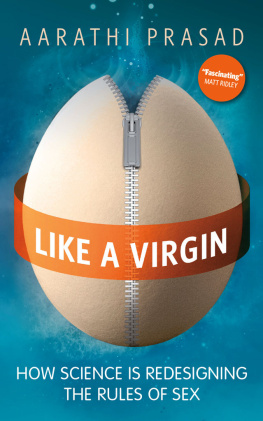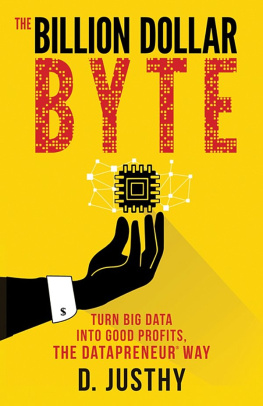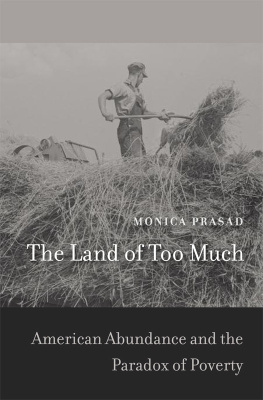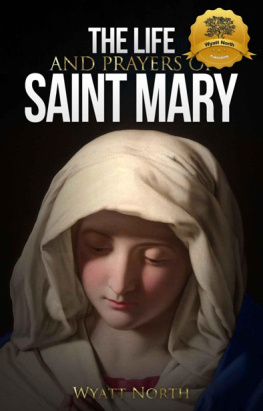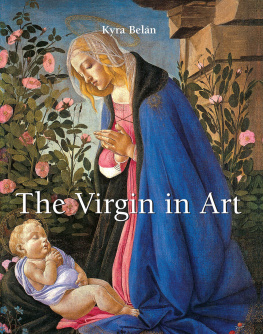LIKE A VIRGIN


A Oneworld Book
Published by Oneworld Publications 2012
This ebook edition published in 2012
Copyright Aarathi Prasad 2012
The moral right of Aarathi Prasad to be identified as the Author of this work has been asserted by her in accordance with the Copyright, Designs and Patents Act 1988
All rights reserved
Copyright under Berne Convention
A CIP record for this title is available from the British Library
ISBN 978-1-85168-911-8
Ebook ISBN 978-1-78074-067-6
Cover design by Dan Mogford
Oneworld Publications
185 Banbury Road
Oxford
OX2 7AR
England
Stay up to date with the latest books, special offers, and exclusives content from Oneworld with our monthly newsletter
Sign up on our website
www.oneworld-publications.com
For my mother, C. D. Nalini, my father, Tarran Persad Rambarran,
and my daughter, Sita-Tara
LIKE A VIRGIN

PROLOGUE

CONCEIVING THE INCONCEIVABLE
For most of human history, women have been given little credit when it comes to childbearing.
Sounds strange, I know. Women clearly carry babies and give birth to them, but you could argue, as many have through recorded history, that the female of the species merely serves as a vessel a kind of living incubator. This sort of thinking was by no means the preserve of the uneducated; the very reason it persisted as long as it did in mainstream cultures and medical practice was because it was tested, endorsed by the great scholars and shapers of medicine, from Plato through to Leonardo da Vinci. Plato appears to have made the claim that only men are complete human beings. Aristotle believed that men had the ability to generate a full human being, and that women were reproductively defective. Some four hundred years later, the physician Galen asserted that the female is imperfect compared with the male. Even when da Vinci made the first accurate drawings of a foetus in utero sketching in chalk a single womb rather than multiple chambers, which were believed to give rise to twins he still compared the growing embryo to the seed of a plant.
Such prejudices were handed down, generation after generation. Take, for example, Thomas Bartholin, a pioneering Danish scientist from an esteemed family of anatomists and medical scholars. Bartholin lived in the seventeenth century and discovered the lymphatic system a finding that would have required a keen eye and the proficiency to carry out a detailed investigation of human anatomy. Yet, when it came to women and pregnancy, he also documented accounts of the birth of monstrosities such as the woman who delivered a rat, or another whose child had the head of a cat, because a cat had frightened her when she was pregnant. The idea that what a woman saw and felt, or that specific shocks or scares during pregnancy, would lead to specific defects in her baby was widespread. Being frightened by a mouse, for example, might lead to the baby having a mouse-shaped birthmark or worse. Today, we would laugh at ideas like this, or dismiss them as urban legend. Why would a great scientist, an empirical type, treat any of these things as conceivable?
But then, many outdated ideas about sex and reproduction still persist in many places around the world. These beliefs at times prevent a woman from claiming full biological ownership of her child, though she is still culpable for any reproductive shortcomings (such as giving birth to a baby with defects; experiencing recurrent pregnancy loss; failing to get pregnant). Even in our genetic age, there are women who are blamed (and who blame themselves) for giving birth to girls instead of boys. On the other hand, while the scientific evidence is still mounting, it appears to be true that a mother who, for instance, suffers stress during pregnancy will leave a lifelong mark on her child. And while we all know that the sperm determines whether a child is a boy (XY) or a girl (XX), new research shows that a womans immune system screens sperm after they have entered her body, and some womens bodies are more likely to discard Y-carrying, boy-making sperm. Many of these ideas, based in fact or fiction, are descendants of the cultural vocabulary of ancient Greece and the Renaissance. Despite the reality of test-tube babies and sperm banks, it seems we havent moved much beyond Bartholins theory of a rat-child or blame being placed at a mothers feet.
Far stranger, however, is another long-lived belief: the concept of a virgin birth. From the fertilization-by-feather of the Aztec Coatlicue to Isiss recipe for resurrecting her dead husband Osiriss phallus, to the Blessed Virgin Mary, there appears to be no culture that does not embrace some legend of a woman giving birth without mortal man. You could imagine that because, in the view of classical thinkers, women were viewed as crude vessels for reproduction, a repository for the vital semen of man, that they could just as easily have their bodies appropriated by their gods (who, of course, are generally male). But the myths extend to active agents that are not all divine. Human virgin births have been said to be caused by such things as sunlight and eating magical fish. These examples illustrate just how compelling was the notion of impregnation without sex, in part because there was so little real understanding, for so long, of how babies are actually made.
We now know that a mother makes an essential contribution of genetic information to her child, as well as providing a protected environment and the physical building blocks for the embryos developing body. Biologically and genetically, women clearly are not mere vessels, nor are they redundant. Still, even when confronted by the double helix of DNA, the combination of the sex chromosomes X and Y, and genetic variants and mutations, the belief in the possibility of virgin birth has proved surprisingly enduring. It has ranged from the technology-fuelled optimism of the post-war boom, when doctors hunted for a virgin mother via the tabloids; to the absurd insurance policy, offered in the past decade, that would cover the cost of bringing up a child should you experience a virgin birth.
The simple truth, for humans at least, is that neither women nor men are currently redundant when it comes to making babies. Though the females of many animal species have the option of reproducing quite on their own, for us, a mutual need was established in our distant evolutionary past, and once that treaty was written in DNA, it could never be broken. Never, that is, until now.
In the future, technology might vindicate a few of the ancient, seemingly absurd concepts at least in some respects. It might someday be possible to create a child from one parent alone. Ironically, because of the way men and womens chromosomes are arranged, the virgin parent will more likely be a man. Geneticists are cracking the codes that block our eggs from becoming embryos without sperm; stem cell scientists are creating eggs and sperm from bone marrow; artificial wombs are being built; artificial chromosomes are being constructed. And it seems not a minute too soon. Both male and female infertility is on the rise, and some scientists are warning that the Y chromosome, the very thing that makes men both fertile and male, is slowly but surely dying; it now has only around forty-five genes of the 1400-odd genes with which it began the human species. If the Y chromosomes genetic information essentially disintegrates, what solution could technology offer to sustain, well,
Next page
